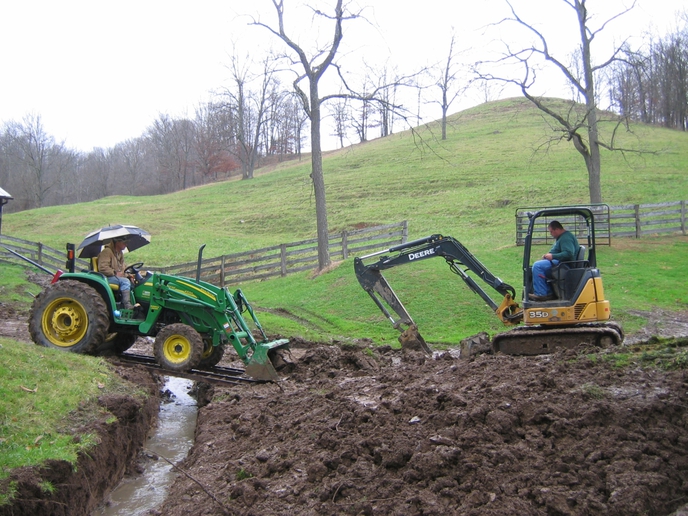Thorough Underbrush Clearing for Land Management
Thorough Underbrush Clearing for Land Management
Blog Article
Culvert Installation Facilitated: Step-by-Step Overview for Success
Mounting culverts may look like an uncomplicated job, yet making sure a successful end result needs careful planning and implementation. From picking the proper culvert size to integrating proper drainage actions, each action in the installment procedure plays a crucial duty in the capability and durability of the culvert system. By complying with a methodical strategy and paying attention to key information, the installation can proceed smoothly, reducing potential issues down the line. Stay tuned to uncover the crucial actions and factors to consider that can make culvert installment a smooth and effective undertaking.
Picking the Right Culvert Dimension
Selecting the proper culvert dimension is vital for making sure efficient water flow and architectural integrity in culvert setup projects - Pad Construction. The size of the culvert straight influences the flow ability of water through the structure. A culvert that is as well small can result in flooding and overflow, while one that is too huge may cause decreased water rate, possibly creating debris buildup and obstructions
To establish the right culvert size, variables such as the watershed location, optimal flow rates, and hydraulic performance requirement to be very carefully thought about. Estimations based upon these parameters help in picking a size that can effectively handle the expected water volume while lessening the danger of blockages and architectural failing.
It is important to seek advice from engineering standards and criteria to make sure that the picked culvert dimension fulfills the task needs and local laws (Pad Construction). By picking the right culvert size, project supervisors can maximize water flow, stop prospective problems, and improve the general performance and longevity of the culvert installation
Preparing the Installation Site
Effective culvert installation necessitates careful prep work of the setup site to guarantee optimum architectural support and functionality. Before starting the installment procedure, it is crucial to remove the site of any debris, plant life, or obstructions that might hinder the culvert's positioning. Making sure a level foundation is necessary for the proper placement and security of the culvert. This might include grading the website to produce a smooth, even surface that can adequately sustain the weight of the culvert and any type of awaited loads. In addition, proper compaction of the dirt underneath the culvert is required to avoid clearing up or moving gradually.
Furthermore, it is necessary to take into consideration elements such as soil structure, groundwater degrees, and environmental effects when preparing the installment website. Conducting a complete site evaluation can aid identify any possible difficulties or risks that may impact the culvert's efficiency. By taking the time to prepare the installment website properly, you can help assure an effective culvert installment that fulfills structural requirements and guarantees long-term functionality.
Placing the Culvert Correctly

The quality at which the culvert is positioned is vital for keeping an appropriate incline for water flow. Furthermore, the culvert ought to be oriented correctly to make sure that the inlet and electrical outlet are in the proper locations. Pad Construction.
Backfilling and Condensing the Soil
Correct backfilling and compaction of the soil around the culvert is necessary to make certain security and prevent possible issues in the future. When the culvert is properly positioned, the next crucial step is to backfill the area around it with ideal material. The backfill material should be without rocks, debris, and organic matter to avoid damages to the culvert. It is suggested to utilize granular material such Visit This Link as sand or gravel for backfilling, as it gives good water drainage and compaction properties.
Compaction aids in minimizing the opportunities of negotiation and ensures uniform support around the culvert. It is crucial to compact the dirt evenly on all sides of the culvert to keep its structural stability.
Correct backfilling and compaction not just offer security to the culvert but additionally help in protecting against soil disintegration and keeping the durability of the culvert system.
Ensuring Appropriate Drainage Combination
Integrating efficient drain remedies plays a crucial role in the general functionality and long life of culvert installations. Correct water drainage assimilation is essential for taking care of water circulation, protecting against disintegration, and ensuring the architectural stability of the culvert system. To attain this, it is crucial to create a thorough water drainage strategy that takes into consideration variables such as the volume of water anticipated, the topography of the area, and the sort of dirt present.

Additionally, integrating functions like erosion control actions, such as riprap or vegetation, can additionally enhance the performance of the water drainage system. By very carefully preparing and carrying out these drain solutions, culvert setups can function successfully and stand up to the test of time.
Verdict
In verdict, proper culvert installment is essential for keeping reliable drain systems. By picking the best culvert size, preparing the installation site, putting the culvert correctly, backfilling and condensing the dirt, and making sure correct drain assimilation, success can be accomplished. Following these actions will assist make certain the longevity and effectiveness of the culvert, inevitably contributing to the total success of the drain system.
Report this page